Without bones, you would be a pile of skin on the floor. Your bones make up a frame for your body. Just like the boards of a house, this frame gives your body shape. It allows you to move and protects all the parts inside, like your brain and heart. Just like your other body parts, your bones are living, changing things. They are always growing, breaking down, and growing again.
Think about a bag of your favorite chips. If you sit on that bag, they will be crushed. The chips take up space, but they cannot hold you up. Now try pouring glue into that bag of chips. Go ahead, fill it all the way up! Once the glue dries, that bag of chips has the same shape it had before, but now it's really strong. Your bones work in the same way. Minerals from the foods you eat attach to softer stuff, making your bones hard. These minerals are the same ones that make rocks as hard as ... well, rocks. Your bones store the minerals until other parts of your body like your muscles or blood vessels, need them. Calcium is the most common mineral in your body, and it is a silvery-white metal. It is stored in your bones and teeth.
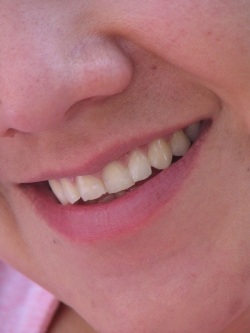
Teeth need calcium to grow strong.
Ernesto Perales Soto from Irapuato, Gto, Mexico, CC BY 2.0 , via Wikimedia Commons
With all the different things that all the parts of your body need, sometimes things can go wrong. Some people do not get enough calcium from the food they eat. One of the ways this can happen is if their body cannot soak up all the things they eat. When this happens, the body has to get this important mineral from somewhere else -- from your bones. This can lead to bones that are full of small holes and can break easily. The condition where people have fragile bones full of small holes is known as osteoporosis. This happens most commonly to women over the age of 50.
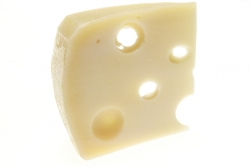
Osteoporosis makes your bones look like swiss cheese.
Renee Comet (Photographer), Public domain, via Wikimedia Commons
To protect yourself from osteoporosis, it is important to make sure you build strong bones when you are young. For most people, by the time they reach age 30, their bones are as strong as they will ever be. To make sure you have strong bones you have to take in enough calcium and move your body. Milk, yogurt, cheese are good choices for strong bones. Running, dancing, and some sports will also make your bones stronger. Things like swimming and bicycle riding do not stress your bones, so they do not make them stronger.
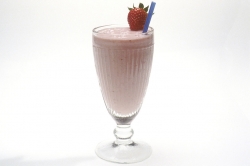
A strawberry milkshake is health food for your bones.
Renee Comet (Photographer), Public domain, via Wikimedia Commons
If you turn sideways and look in a mirror, you might notice that your spine has a little curve to it. This is healthy, but the wrong bend in your spine can be bad. Some people get a sideways curve in their spine, which may look like a letter C or S. Most often this happens in girls after the age of 10. There is no known cause, but it does run in families. Scoliosis is when the spine has sideways curve.
In most cases, there is no way to keep it from happening. For a small curve, you may not need to do anything. Sometimes, if the curve is caused by a spasm or swelling, the curve can be fixed by treating the cause. For those with unknown causes, some curves may need treatment if they are bad enough. In these cases, doctors may have you wear a brace to help straighten out the curve. Sometimes you might also need surgery.
Bones can bend, but not too far. They can be hurt by your body hitting something or bending in a direction it is not supposed to. This could happen in a car accident, while playing a sport, or from a fall. Sometimes bones can also be hurt from pounding over and over again, like when your shins hurt from too much running. A broken bone is when a bone cracks or splits. This is also sometimes called a fracture.
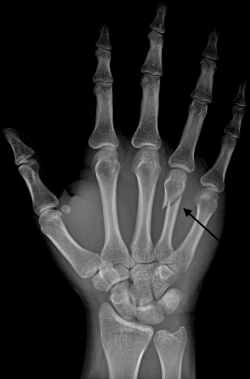
Maybe next time I won't just go for it.
The best way to protect against broken bones is to make sure you have strong bones to start with by exercising and taking in calcium. You also need to protect your body by wearing the right sports pads. Seat belts can also prevent broken bones caused by car accidents. Do not stand on chairs, counters, or other things that are not built for standing. Also, make sure to keep things picked up off the floor so people do not trip and fall.
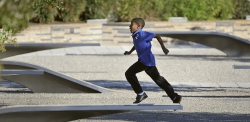
Not only is this fun but it's good for my bones too.
Glenn Fawcett, Public domain, via Wikimedia Commons
Bones are tough stuff, but not so tough that they cannot be hurt. Sometimes things that happen to bones, like a sideways curving backbone, cannot be stopped. You can, though, stop most things from hurting you, like osteoporosis and broken bones. The key is healthy eating, working out, and taking care when playing sports, driving in the car, or hanging out at home.
References: Abrams, Steven, Bess Dawson-Hughes, Robert Heaney, Elizabeth Krall, James M. Shikany, Dennis Savaiano, Paul Thomas, Connie Weaver. "Dietary supplement fact sheet: calcium." Pamphlets by: National Institutes of Health, Office of Dietary Supplements. Dec 2007. Web. 7 Feb. 2013.
Bennett, Mike. "Skeletal system." AccessScience. McGraw-Hill Companies, 2008. Web. 17 Dec. 2012.
"Bone, ligaments, tendons." World of Sports Science. Ed. K. Lee Lerner and Brenda Wilmoth Lerner. Detroit: Gale, 2007. Gale Science In Context. Web. 3 Dec. 2012.
"Bone Substitutes." Biotechnology: Changing Life Through Science. Detroit: U*X*L, 2012. Gale Science In Context. Web. 8 Feb. 2013.
"Broken Bone." Encyclopedia. University of Maryland Medical Center. 2 May 2009. Web. 12 Feb. 2013.
Jenkins, Steve. Bones. New York: Scholastic Press, 2010. Print.
"Orthopedics." U*X*L Encyclopedia of Science. U*X*L, 2007. Gale Science In Context. Web. 8 Feb. 2013.
"Osteoporosis overview." NWHRC Health Center - Osteoporosis. 30 May 2006. Web. 7 Feb. 2013.
"Preventing Broken Bones." Health Encyclopedia. University of Rochester Medical Center. N.d. Web. 12 Feb. 2013.
"Q Is it true that bones are stronger than concrete?" WHAT'S UP, DOC? Current Health Teens, a Weekly Reader publication. Sept 2011. v38 i1 p23(1). Web. 17 Dec. 2012.
"Questions and answers about scoliosis in children and adolescents." Pamphlet by: National Institute of Arthritis and Musculoskeletal and Skin Diseases. 5 Jun. 2012. Web. 7 Feb. 2013.
Rouzier. Pierre. "Stress Fractures." RelayClinical Education. Feb 2012 v2012 i1. Web. 8 Feb. 2013.